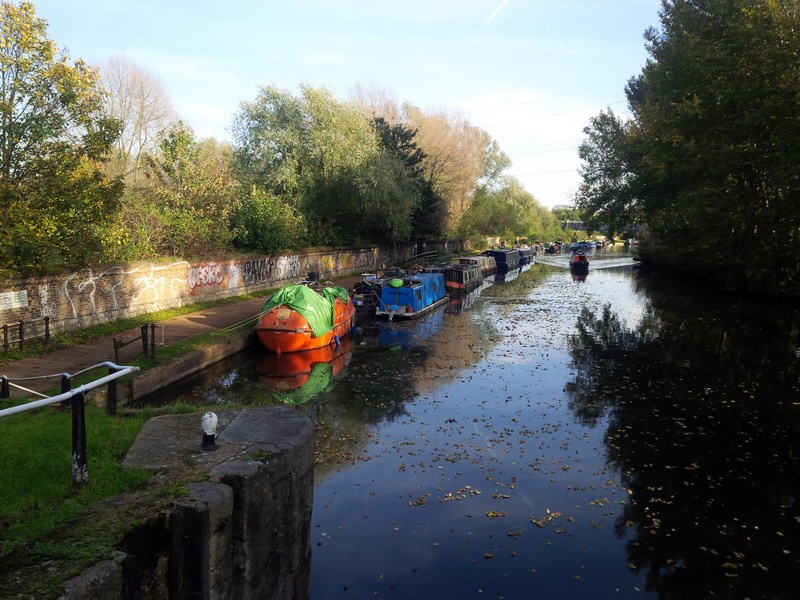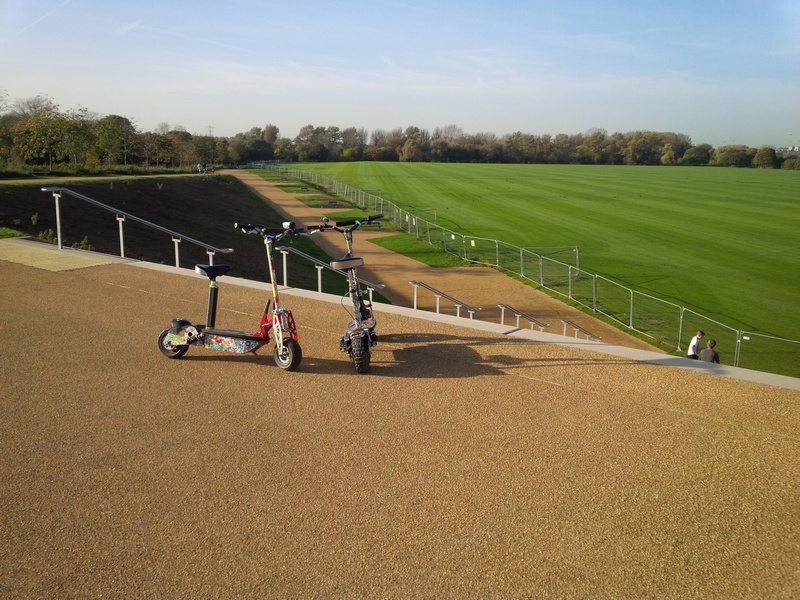The Hackney Cut

The changing ecologies of clean and dirty. As the river Lea bends and turns in through Hackney Marsh, it leaves a part of the commons known as East Marsh on the other side. This connects to the rest of the marsh through the White House Bridge named after the pub that once stood there before World War 1. With the barriers for the 2012 Olympics all this has been out of bounds. Now after 5 years the barriers have gone and it's possible to cross the bridge again.
The White House Bridge is a pretty spot, hemmed in by trees and the gentle flow of water. There are no ghost traces of times bygone. Factories and unregulated industrial activity would have lined these banks of the Lea at the onset of the industrial revolution. The scale of congestion then led to conflict between factory owners and barge owners over access to the river. This conflict was resolved by splitting the Lea at various points. Here it took place at the Hackney Cut in 1769 at the north end of marsh, doubling the river into two, one for the factories and one for barges. Each time I pass by the Cut, I often see a lone heron there. I imagine it marking this spot symbolically as a perfect manipulation of nature in the service of human disputes (though I can understand it's there to take advantage of the upsurge of current as the fish flow by).

It could be argued that one part of the Lea is natural, the other artificial. The distinction between the man-made and the natural has a long genealogy in Western discourse. The geographer Neil Smith traces it from the ancients through to Hegel's first nature and its blind necessity and a purposive second nature. But if any stretch of waterway anywhere in the world has borne the changing relation between humans and nature that came with the industrial revolution, it's the Lea. Some say that the Lee was the original and the Lea is the man-made but few today know which is which. Lea and Lee are totally interchangeable.
As London grew with increasing industry, the barges on the Lea provided an ecological lifeline between city and countryside. The use of horse-drawn transport provided ample manure along with human waste for the city-country ecological balance sheet to be kept in check. That balance was blown asunder by coal and fossil fuel, modern forms of transport, sewers and sanitation. But as the industrialisation came and went, so did the factories now 'disappeared' to far flung parts of the world. The last one by the marsh, the Matchbox Toy factory closed in 1990.
With the disappearance of the factories, our rivers have become cleaner - to a degree as anyone who has fallen into the Lea, as I have done, will know. But the nature I see and enjoy on the bridge is a man-made mise-en-scene with an ecological price to pay in our age of non-renewables. As a river the Lea now flows into the ecosystem of a modern city that would demand 300 times the energy consumption of any natural ecosystem. One could compile an audit based on the global-local imbalances but we can start locally with modern sanitation. Once our night soil (human excrement) used to go back to the country soil with the barges on the river, but now it simply drains into the sewer system. Clean can be ecologically dirty. There is nothing logical about having to use several litres of clean water to flush a small amount of organic waste to another place many miles away whereafter ten times as much water is used to treat and return it to a reservoir; for the cycle to start anew.

The Lea is part of a complex evolutionary mosaic that slowly saw a 4000 hectare nature reserve, the Lee Valley Park, take shape along the spine of the river – a thin green chilli all the way from Essex to the Thames estuary that I often cycle through on my commutes. These nature reserves came out of the voluntary movements like the Open Spaces movement of the 19th century, then the Commons Preservation Society that sought to protect remnants of nature surviving in our cities.
Whilst the aesthetic owes much to the English landscape movement, a merging of unkempt countryside and the aristocratic estates that grew out of colonial extraction, perhaps the key outcome of the emerging relationship between the urban environment and the natural wilderness was wrest insitu out of the "New World" through the creation of nature parks. The ethos was the "greatest good of the greatest number for the longest time" as put by the American forester Gifford Pinchot. This 'greatest good of the greatest number for the longest time' in effect articulated a project of re-naturing Nature; Nature for an urban population that would stand outside its politics. The historian Samuel Hays' Conservation and The Gospel of Efficiency sketched out a progression from conservation to preservation in the early days to pave the way to the environmental movement in the mid-twentieth century and onto a politics of environmentalism.
If the emergence of environmentalism brought a new dimension of the political, after the Rio summit on climate change and global warming came the development of what might be called counter-projects that blend nature, market, society and technology. Maarten Hajer's essay Ecological modernisation as cultural politics gives an insight into the processes and permutations that integrate nature into economic orthodoxies through the 'technicisation of ecology', 'the translating of a social and moral issue into a market issue'.
Ecological modernisation has become intrinsic to the language of urban greening policy and essential to marketing the sustainable Olympics. So that with eco-alibis, vast tracts of working land and common space can be taken, reshaped and returned conditionally. The appropriation of a body of the Commons is analogous to the right of habeas corpus, and never without apprehensions. Once in custody, nothing is ever the same.

So now it's handed back, we can ask what has changed at East Marsh? This bit of the Commons has certainly been straightened up. Traces of the Olympic car park have been removed and the marshland re-turfed. Right next to the White House Bridge, there's a hive of activity at the Hackney Marshes Centre the new changing facilities paid for through the Olympic Legacy. The entire architecture has been temporarily draped in advertising by Adidas. With its symbolism of human-animal morphing using a new type of football boot, #predatorinstinct is seductive for any young footballer. It's a marketing strategy scaling up to Nature, to set up a competing visual hierarchy. As a temporary intrusion it's somehow acceptable for the money it puts into the community purse in these difficult times. But this is too soon a reminder of the scale of corporate branding that was pressed onto ordinary life during the 2012 Games. It's over extending the Adizones concept as part of Adidas' sponsorship of the 2012 games. Adizones were described as 'innovative multisport facilities designed in the shape of the 2012 Olympic logo' to get more young people and families into sport and physical activity.
The eased incursion of marketing culture into the space of amateur sport is a problematic legacy outcome. And the marketing references to opportunities for the ethnic minorities are somewhat ill fitting. Here in 'ethnic' Hackney afar from opportunities for advertising, the social criteria for participation in sport are access and cost. The anomaly in the Olympic legacy, highlighted often enough by disparate groups, is in fact the increased cost to community following the Olympic games.

Just by the Hackney Marshes Centre is the Hackney Marshes community nursery where the social enterprise Growing Communities have several polytunnels growing salads sold through organic box schemes. In contrast, the Hackney Marshes Centre café comes with franchises pre-linked to commercial supply chains with usual branding. Within this small corner of the marshes, connections between nature, food, sport and community are like ships that pass each other in the night. With all the thinking that has gone into the Olympic legacy's sustainability, the jigsaw of opportunities doesn't fit the disconnects in everyday life. But in the current order of things, the deep disconnects have a purpose in service of the status quo. From the expropriation by market forces adapting nature for a new ecological language to the cultural codes of environmental politics that frame its social agency. Thus the appeal of a way out, a 'posthumanist' future with hybrid forms of agency for another kind of environmental politics.

Looking south from East Marsh, it's now possible to see the Lea on its way through a cleared horizon to the Archelor Mittal orbital. The only thing that separates the marshes from the Olympic Park, green from green, is the A12 motorway with the ceaseless flow of cars along with the sense of a drain in social memory. In just a few years a lot has been blown away for this clear line of sight. For better or for worse, who knows?
A generation ago a few minutes of a drive up this motorway was the site of the M11 anti-roads protest movement. Eulogised in George McKay's Senseless Acts of Beauty, it was an amalgam of anarcho-punk, rave culture and New Agerisms confronting the new means of policing society that came with the CJA, the Criminal Justice Act and the Public Order Act 1994. Nothing exists now of the self-declared independent free area of Wanstonia. The radical journal Aufhebung became a voice of environmentalism resistance. Hegel's term Aufhebung - translatable in various ways as "to abolish", "to preserve", "to transcend", "to change" - was used to reflect on the state of our human to nature inter-relations. One line in Aufhebung's issue#5 1996 still rings out:"the fallacy of composition - by arguing that since individual capitalists have strategies, then capital as a whole has a strategy." In thinking of the possibilities open to us twenty years on, the line couldn't be more pertinent especially if we substitute the word 'capital' in the sentence for 'environment' or 'ecology' or 'society' to open up the argument. And then to see the project of 'cleaning and greening' as a way to a fairer participatory society and to repair the planet's ecology.
London once had many rivers flowing into the Thames but the associations of a working river, filth, effluence and the poor, meant they were all filled in or forced underground into the sewer system. The Wandle in the south west of the city still flows. And thanks to the dirty trades of east London, in what's now the Olympic Park so does the Lea. But gone from memory, as Tom Bolton recounts, are the rivers Walbrook and the Fleet in the City, the Tyburn which flowed through Hampstead and Mayfair. But they may yet be resurrected for the supporting roles that nature is called upon for. Bridges and waterways are opened and closed, connected and disconnected. The switchboards between human and nature have become more convertible than ever before and as Neil Smith pointed out, "the human-nature argument is the lucrative investment in the bourgeois portfolio".
To walk across the marsh, from the East to the South marsh and to the North through the wavy horizon, at times I wonder if it's possible to imagine nature outside of this. Back at where I started, the heron is still there. As first nature or second nature becomes a question of doubt. Of the Hackney Cut there is no doubt; the cut is 'terminal' but it has played its role in the way this working river now flows to another future.

